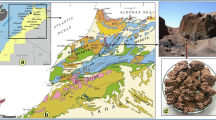Abstract
Geopolymer is the inorganic polymer commonly made from kaolin, clay, fly ash, or slag. Obsidian mineral is the new candidate material for geopolymer formation. Obsidian is a material that used in ancient eras, but nowadays, this function has been replaced by various metals. Obsidian consists of cristobalite and sodium aluminum silicate. Obsidian was reacted with disodium metasilicate (Na2SiO3) to form a mineral-based geopolymer. An analysis of the formation mechanism through X-ray diffraction and Fourier transform infrared spectroscopy showed that the geopolymer formation from obsidian takes place in two stages. The first stage is the formation of a geopolymer from a reaction among cristobalite, disodium metasilicate, and amorphous aluminum silicates, whereas the second stage is the incorporation of crystalline sodium aluminum silicate into the former geopolymer structure. Geopolymer is usually utilized to form brick or concrete for an infrastructure purpose, but in this research, the geopolymer is proposed to control the release rate of elements from fertilizer. The result of potassium release test shows that the geopolymer has a slow-release property.
Similar content being viewed by others
References
J. Davidovits, "Geopolymer Chemistry and Application, Institute of Geopolymer", 2nd ed., 2011, Institute of Geopolymer, France.
M.I. Abdul Aleem and P.D. Arumairaj, Int. J. Eng. Sci., 2012, 1, 118.
B.V. Rangan, Indian Concr. J., 2014, 88, 41.
F. Pelisser, B.V. Silva, M.H. Menger, B.J. Frasson, T.A. Keller, A.J. Torii, R.H. Lopez, Rev. Ibracon Estrut. Mater., 2018, 11, 535.
M.B. Diop, L. Molez, A. Bouguerra, A.N. Diouf, M.W. Grutzeck, Arab J. Sci. Eng., 2014, 39, 4351.
B. Kallesten, S. Kakay, K. Gebremariam, in 2nd Conference of Computational Methods in Offshore Technology and First Conference of Oil and Gas Technology, 2019, Stavanger, Norway.
A.M.M. Al Bakri, H. Kamarudin, M. Bnhussain, I.K. Nizar, A.R. Rafiza, Y. Zarina, Rev. Adv. Mater. Sci., 2012, 30, 90.
M.B. Ali, R. Saidur, M.S. Hossain, Renew. Sust. Energ. Rev., 2011, 15, 2252.
C. Chen, G. Habert, Y. Bouzidi, A. Jullien, J. Clean. Prod., 2010, 18, 478.
A. Nmiri, N. Hamdi, O. Yazoghli-Marzouk, M. Duc, E. Srasra, J. Mater. Environ. Sci., 2017, 8, 676.
P. Hâjkovâ, Minerals, 2018, 8, 444.
C.P. Gonzalez, A.M. Montano, A.K. Gonzalez, C.A. Rîos, in The International Congress of Mechanical Engineering and Agricultural Sciences-CIIMCA, 2011, Floridablanca, Santander, Colombia.
N. Hamdi, I.B. Messaoud, E. Srasra, C.R. Chim., 2019, 22, 220.
A.Z.W. Wazien, M.M.A. Abdullah, R.A. Razak, M.R. Rozainy, M.F.M Tahir, in International Conference on Innovative Research—ICIR Euroinvent, 2016, Iasi, Romania.
S. Samantasinghar and S.P. Singh, Int. J. Concr. Struct. Mater., 2019, 13, 1.
X. Huang, L. Yu, D.W. Li, Y.C. Shiau, S. Li, K.X. Liu, Mater. Res. Innovations, 2015, 19, 413.
J.E. Ericson, A. Makishima, J.D. Mackenzie, R. Berger, J.-Non Cryst. Solids, 1975, 17, 129.
M.R. Fauzi, Kalpataru, 2017, 26, 14.
M.R. Fauzi, F.S. Intan, A.S. Wibowo, J. Archaeol. Sci. Rep, 2019, 24, 166.
M. Spriggs, C. Reepmeyer, P.L. Anggraeni, W.P. Ronquillo, T. Simanjuntak, G. Summerhayes, D. Tanudirjo, A. Tiauzon, J. Archaeol. Sci., 2011, 38, 2873.
Y.V. Kuzmin, Quat. Int., 2017, 442, 5.
R.E. Hughes, D.H. Wera, Z. Sulgostowska, Quat. Int., 2018, 468(A), 84.
D.I. Godfrey-Smith and N. Haywood, Ontario Archaeol., 1984, 41, 29.
M.V. Fernandez, C.R. Stern, P. Leal, Quat. Int., 2015, 375, 44.
R. Campbella, C.R. Stern, A. Penalozac, J. Archaeol. Sci. Rep., 2017, 13, 617.
D. Qiao, H. Liu, L. Yu, X. Bao, G.P. Simon, E. Petinakis, L. Chen, Carbohydr. Polym., 2016, 147, 146.
J.F. Mukerabigwi, Q. Wang, X. Ma, M. Liu, S. Lei, H. Wei, X. Huang, Y. Cao, J. Coat. Technol. Res., 2015, 12, 1085.
Solihin, Metalurgi, 2013, 28, 1.
Q. Zhang, W. Tongamp, F. Saito, Powder Technol., 2011, 212, 354.
W. Yuan, Solihin, Q. Zhang, J. Kano, F. Saito, Powder Technol., 2014, 260, 22.
M.N. Khan, M. Mobin, Z.K. Abbas, S.A. Alamri, Encycl. Anthropocene, 2018, 5, 225.
J.H. Im and C.O. Choo, Econ. Environ. Geol., 2017, 50, 105.
M.C.G. Castorena, "Pedogenic Siliceous Features, Interpretation of Micromorphological Features of Soils and Regoliths", ed. G. Stoops, V. Marcelino, F. Mees, 2nd ed., 2018, Chap. 6, Elsevier B.V., Amsterdam.
Acknowledgments
The research was funded by The National Priority Research Program, which was coordinated by the National Development
Author information
Authors and Affiliations
Corresponding author
Rights and permissions
About this article
Cite this article
Solihin, S., Rizqiadi, A. & Handayani, I. An Analysis of the Formation Mechanism of Geopolymer Made from Obsidian Mineral and Its Potential Application as a Slow Release Fertilizer. ANAL. SCI. 36, 1401–1405 (2020). https://doi.org/10.2116/analsci.20P182
Received:
Accepted:
Published:
Issue Date:
DOI: https://doi.org/10.2116/analsci.20P182




